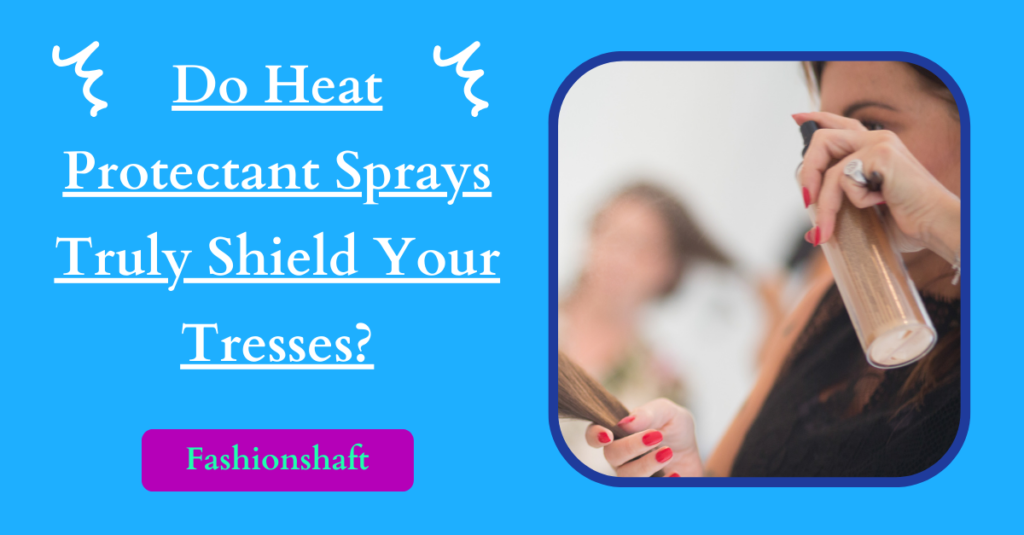Do Heat Protectant Sprays Truly Shield Your Tresses?
Introduction
The battle against heat damage is as old as the invention of curling irons and straighteners. Enter the hero: heat protectant sprays. These seemingly magical potions promise to shield our precious locks from the ravages of heat styling, offering salvation in the form of sleekness, shine, and vitality. But do they truly deliver on their promises?
As we embark on this quest for truth, it’s crucial to unravel the mysteries shrouding these products. We’ll delve into the science behind their formulation, explore the evidence supporting their efficacy, and navigate the murky waters of skepticism and critique. Join us on this journey to uncover the secrets behind heat protectant sprays and determine whether they’re indeed the knights in shining armor our hair deserves or merely illusions in a bottle.
Understanding Heat Damage
Before we embark on our quest for answers, it’s essential to understand the enemy we’re up against: heat damage. When subjected to high temperatures, the cuticle – the outermost layer of the hair shaft – becomes compromised, leading to moisture loss, breakage, and dullness. Prolonged or frequent exposure to heat styling tools can exacerbate these effects, leaving hair brittle, frizzy, and prone to split ends.
The Promise of Heat Protectant Sprays

In the battle against heat damage, heat protectant sprays emerge as our allies. These formulations typically contain a cocktail of ingredients designed to create a protective barrier between the hair shaft and the heat source. Silicone-based compounds, such as dimethicone and cyclomethicone, are common ingredients in heat protectant sprays, forming a hydrophobic coating that helps to repel moisture and reduce heat transfer to the hair.
Unraveling the Science
But how exactly do these seemingly miraculous sprays work their magic? The science behind heat protectant sprays lies in their ability to distribute heat evenly and minimize thermal stress on the hair shaft. By forming a barrier between the hair and the heat source, these products help to reduce the temperature gradient across the hair surface, thereby mitigating the damaging effects of heat styling.
Moreover, certain heat protectant ingredients, such as panthenol and keratin, boast reparative properties that help to strengthen and fortify the hair structure. By infusing the hair with moisture and protein, these ingredients work to minimize the extent of damage caused by heat styling, leaving hair smoother, softer, and more resilient.
The Evidence for Efficacy
But do heat protectant sprays live up to their lofty claims? The answer, according to scientific research and anecdotal evidence, appears to be a resounding yes. Numerous studies have demonstrated the efficacy of heat protectant sprays in reducing thermal damage and preserving hair integrity during heat styling.
For instance, a study published in the Journal of Cosmetic Science found that the application of a silicone-based heat protectant spray resulted in a significant reduction in the extent of heat-induced damage to the hair cuticle compared to untreated hair. Similarly, a clinical trial conducted by a leading hair care brand reported that subjects who used a heat protectant spray experienced fewer instances of breakage and split ends after heat styling compared to those who did not use any protective products.
Navigating Criticisms and Challenges
Despite the overwhelming evidence supporting their efficacy, heat protectant sprays are not without their critics. Some skeptics argue that these products offer little more than a false sense of security, masking damage rather than preventing it. Others raise concerns about the potential buildup of silicone residues on the hair, which could weigh it down and dull its luster over time.
Moreover, the effectiveness of heat protectant sprays can be influenced by factors such as application technique, product quality, and individual hair type. Improper application – such as applying too much product or failing to distribute it evenly – can compromise the efficacy of the spray and leave hair vulnerable to heat damage.
Conclusion
So, do heat protectant sprays truly shield your tresses? The evidence overwhelmingly suggests that they do. From their scientifically proven ability to reduce thermal damage to the countless testimonials attesting to their transformative effects, heat protectant sprays have earned their place as essential tools in the quest for healthy, beautiful hair.
However, like any hair care product, the key to unlocking the full potential of heat protectant sprays lies in understanding how to use them properly and choosing the right product for your hair type and styling needs. By incorporating a heat protectant spray into your hair care routine and following best practices for heat styling, you can enjoy the benefits of sleek, shiny locks without sacrificing their health and vitality. So go ahead, heat style with confidence – your tresses will thank you for it.

My name is Rohit Vagh and I’m a content writer specializing in fashion and lifestyle. I have three years of experience in this field and have written various articles. My writing style is creative and engaging, and I strive to create content that resonates with my readers. I have a deep passion for fashion and am constantly researching the latest trends and styles to make sure my readers are up to date. I’m excited to continue my career in blogging, and I’m always looking for new opportunities in the fashion and lifestyle space.





